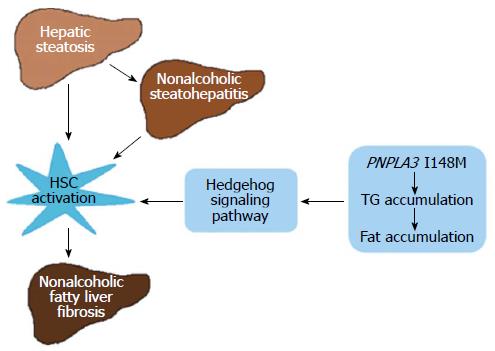Copyright
©The Author(s) 2015.
World J Gastroenterol. Jan 21, 2015; 21(3): 794-802
Published online Jan 21, 2015. doi: 10.3748/wjg.v21.i3.794
Published online Jan 21, 2015. doi: 10.3748/wjg.v21.i3.794
Figure 1 Simplified schematic model showing the hypothetical molecular mechanism by which the PNPLA3 I148M variant participates in the development and progression of nonalcoholic fatty liver fibrosis.
The hedgehog signaling pathway links PNPLA3 with the activation of hepatic stellate cells, which is considered as the central part of fibrogenesis. PNPLA3 protein exhibits activities of lysophosphatidic acid acyltransferase and acylglycerol hydrolase to maintain the TG balance in the liver. The “gain function” of the PNPLA3 I148M variant causes Triglyceride (TG) accumulation in the liver, which accelerates the progression of nonalcoholic fatty liver disease. HSC: Hepatic stellate cell.
-
Citation: Chen LZ, Xin YN, Geng N, Jiang M, Zhang DD, Xuan SY.
PNPLA3 I148M variant in nonalcoholic fatty liver disease: Demographic and ethnic characteristics and the role of the variant in nonalcoholic fatty liver fibrosis. World J Gastroenterol 2015; 21(3): 794-802 - URL: https://www.wjgnet.com/1007-9327/full/v21/i3/794.htm
- DOI: https://dx.doi.org/10.3748/wjg.v21.i3.794









